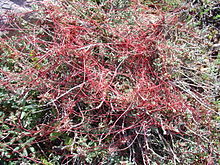
Cuscuta, commonly known as dodder, is a genus of over 201 species of yellow, orange, or red parasitic plants. Formerly treated as the only genus in the family Cuscutaceae, it now is accepted as belonging in the morning glory family, Convolvulaceae, on the basis of the work of the Angiosperm Phylogeny Group. The genus is found throughout the temperate and tropical regions of the world, with the greatest species diversity in subtropical and tropical regions; the genus becomes rare in cool temperate climates, with only four species native to northern Europe.

Convolvulaceae, known commonly as the bindweed or morning glory family, is a family of about 60 genera and more than 1,650 species of mostly herbaceous vines, but also trees, shrubs and herbs, and also including the sweet potato and a few other food tubers.

Cassytha is a genus of some two dozen species of obligately parasitic vines in the family Lauraceae. Superficially, and in some aspects of their ecology, they closely resemble plants in the unrelated genus Cuscuta, the dodders. When fruit and flowers are absent in the field, the physical resemblance is so close that few people without technical training can tell them apart. In this respect and in their ecology the two genera present a spectacular example of convergent evolution. Nonetheless, Nickrent comments that "Cassytha is uneqivocally assigned to Lauraceae based on (both) morphological and molecular data." In its divergence from habits typical of the Lauraceae, Cassytha also presents examples of mosaic evolution

A parasitic plant is a plant that derives some or all of its nutritional requirement from another living plant. They make up about 1% of angiosperms and are found in almost every biome. All parasitic plants have modified roots, called haustoria, which penetrate the host plant, connecting them to the conductive system – either the xylem, the phloem, or both. For example, plants like Striga or Rhinanthus connect only to the xylem, via xylem bridges (xylem-feeding). Alternately, plants like Cuscuta and Orobanche connect only to the phloem of the host (phloem-feeding). This provides them with the ability to extract water and nutrients from the host. Parasitic plants are classified depending as to the location where the parasitic plant latches onto the host and the amount of nutrients it requires. Some parasitic plants are able to locate their host plants by detecting chemicals in the air or soil given off by host shoots or roots, respectively. About 4,500 species of parasitic plant in approximately 20 families of flowering plants are known.

Cuscuta californica is a species of dodder known by the common names chaparral dodder and California dodder. This is an annual parasitic plant that may resemble fine strands of spaghetti or twine strewn across other species in its habitat. A mature plant of this species may fulfill all of its food and water needs from the host plant, but they rarely kill their host. It is native to western United States and Baja California in Mexico.

Cuscuta europaea, the greater dodder or European dodder, is a parasitic plant native to Europe, which belongs to the family Convolvulaceae, but was formerly classified in the family Cuscutaceae. It grows on Asteraceae, Cannabaceae, Chenopodiaceae, Fabaceae, Urticaceae and other herbaceous plants, including garden plants such as Coleus and Impatiens. It is a notable parasite of lucerne. In many regions, including the Nepal Eastern Himalayas, this species are used as traditional medicine to treat hepatic diseases.

Cuscuta approximata is a species of dodder known by the common name alfalfa dodder. It is native to Eurasia and Africa, but it is also found in North America, where it is an introduced species and uncommon noxious weed. It is a parasitic vine which climbs other plants and takes nutrition directly from them via a haustorium. The dodder resembles a pile of light yellow to orange-red straw wrapped tightly around its host plant. It is mostly stem; the leaves are reduced to scales on the stem's surface, since they are not needed for photosynthesis while the dodder is obtaining nutrients from its host. It bears clusters of tiny yellowish bell-shaped flowers which are only about 3 millimeters wide. The dodder reproduces by seed, with each plant capable of producing over 10,000 seeds at once. This plant is a weed of alfalfa, clover, and tomatoes, as well as other crop plants and native flora. This species is sometimes treated as a subspecies of Cuscuta epithymum.
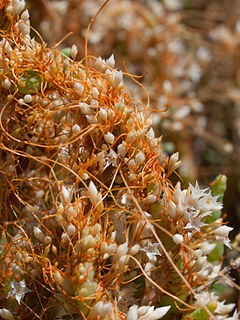
Cuscuta salina is a species of dodder known by the English name salt marsh dodder and is a native plant of western North America. The habitat includes coastal tidal wetlands in California, as well as saline habitats away from the coast, such as vernal pools and salt flats. Salt Marsh Dodder is a parasitic plant, wrapping orange-colored stems around natural wetland vegetation and absorbing nutrients of host plants via their specialized structures called haustoria.

Cuscuta campestris, with the common names field dodder, golden dodder, large-seeded alfalfa dodder, yellow dodder and prairie dodder, is a parasitic plant which belongs to the family Convolvulaceae. It was formerly classified in the family Cuscutaceae.

Cuscuta japonica, commonly known as Japanese dodder, is a parasitic vine. It has been listed by the State of California as a noxious weed. It has a range of effects on its host and has repeatedly been introduced to the United States of America. C. japonica looks very similar to other vines, making it difficult to distinguish.
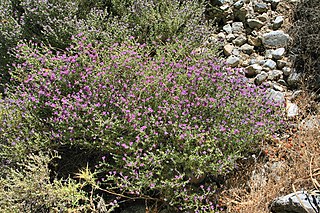
Thymus capitatus is a compact, woody perennial native to Mediterranean Europe and Turkey, more commonly known as conehead thyme, Persian-hyssop and Spanish oregano. It is also known under the name Thymbra capitata.

Treen Cliff is a Site of Special Scientific Interest (SSSI) located on the Penwith Peninsula in Cornwall, England, UK, 6 miles (9.7 km) south-west of Penzance. First notified in 1951, with a revision in 1973, and a further notification on 1 July 1986, it is 49.3 hectares in area, stretching from grid reference SW387220 to SW402225. Designated for both for its biological and geological interest, part of the site, Treryn Dinas, is a Scheduled Ancient Monument consisting of a "cliff castle" with four ramparts and ditches and the Logan Rock. It is within the Cornwall Area of Outstanding Natural Beauty (AONB), the Penwith Heritage Coast and is part owned and managed by the National Trust.
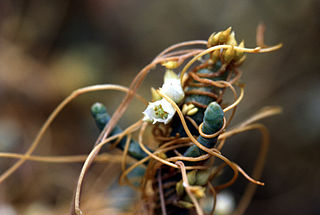
Cuscuta pacifica is a species of dodder. Its common name is goldenthread.

Cuscuta denticulata, commonly known as desert dodder or small-toothed dodder, is a thin, yellow to orange, parasitic annual vine in the morning glory family (Convulvulaceae), native to the deserts of the south-western United States and northern Mexico.

Cuscuta reflexa, the giant dodder, is one of 100-170 species in the genus Cuscuta.

Cuscuta compacta, the compact dodder, is a parasitic plant that specializes on woody plants. This species is distributed across the Eastern and Midwestern USA, Eastern Canada, and Mexico.

Cuscuta australis, commonly known as Australian dodder, is a herb in the family Convolvulaceae.
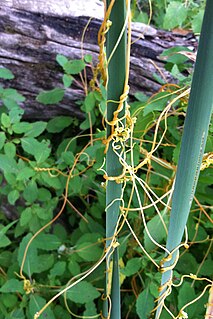
Cuscuta gronovii is a yellow vine that grows as a parasite off other plants. It is a dicot.
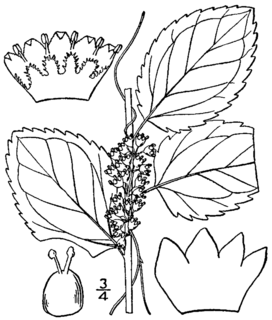
Cuscuta coryli, synonym Grammica coryli, common name hazel dodder, is a perennial plant in the Cuscutaceae family native to North America.
